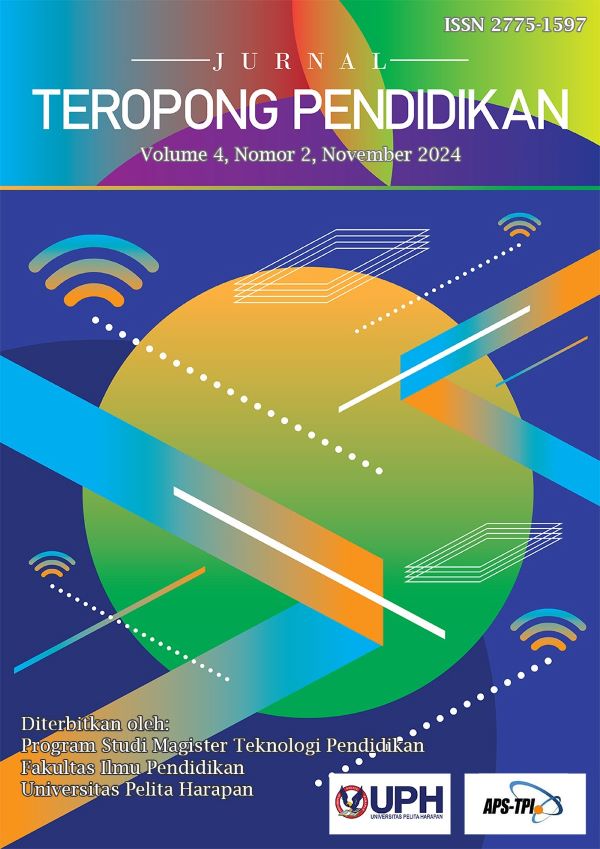Menguji Virtual Reality Dengan Metode Pembelajaran Konvensional di Kalangan Gen - Z Atau Alfa [Testing Virtual Reality with Conventional Learning Methods Among Gen - Z Or Alpha]
DOI:
https://doi.org/10.19166/jtp.v4i2.7713Keywords:
Virtual Reality, Conventional Learning Methods, Generation Z, Generation Alfa, Gen Z, Gen AlphaAbstract
This study highlights the need for the education system to adapt to the rapid development of technology, especially in response to changes in student behavior, particularly those from Generation Z and Alpha. The researcher suggests that effective learning methods can no longer rely solely on a single approach, such as the traditional verbal method, but must integrate other methods, particularly the use of technology like virtual reality (VR), to create more engaging and effective learning experiences. Based on the results of this study, which used a qualitative approach with virtual reality as the research instrument, 80% of respondents found learning with VR to be enjoyable, while only 3 out of 15 respondents showed interest in conventional methods. These findings indicate that the use of technology, especially VR, has great potential to meet the preferences of younger generations, who are more accustomed to technology and require a more interactive and innovative approach to learning. This research provides valuable insights for educators to consider incorporating technology into the learning process, as a way to address the behavioral changes and needs of Generation Z and Alpha, who are more dynamic. By leveraging technology, educators can create a more enjoyable and effective learning environment, ultimately improving students' learning outcomes.
References
Ellis, S. R. (2002). What are virtual environments?. Computer Graphics and Applications, 14(1), 17–22. https://doi.org/10.1109/38.250914
Grassini, S., & Laumann, K. (2020). Questionnaire measures and physiological correlates of presence: A systematic review. Front Psychology 11(349), 1–21. https://doi.org/10.3389/fpsyg.2020.00349
Huang, Y. P., Zheng, X. L., Chiu, C. K., Lei, J., Yang, G., Kim, H., & Wang, F. (2021). Towards figurative expression enhancement: Effects of the SVVR-supported worked example approach on the descriptive writing of highly engaged students. Sustainability, 13(21), 1–19. https://doi.org/10.1111/bjet.13247
Putri, R. A. (2023). Pengaruh teknologi dalam perubahan pembelajaran di era digital. Journal of Computers and Digital Business, 2(3), 105–111. http://dx.doi.org/10.56427/jcbd.v2i3.233
Rauschnabel, P. A., Felix, R., Hinsch, C., Shahab, H., & Alt, F. (2022). What is XR? Towards a framework for augmented and virtual reality. Computer Human Behavior, 133, 1–18. https://doi.org/10.1016/j.chb.2022.107289
Susongko, P. (2010). Perbandingan keefektifan bentuk tes uraian dan testlet dengan penerapan Graded Response Model (GRM). Jurnal Penelitian dan Evaluasi Pendidikan, 14(2), 269–288. http://dx.doi.org/10.21831/pep.v14i2.1082
Yuliandari, R. N. (2020). Pola pendidikan dan pengasuhan generasi alpha. Inventa: Jurnal Pendidikan Guru Sekolah Dasar, 4(2), 108–116. http://dx.doi.org/10.36456/inventa.4.2.a2438
Zhao, Q. (2009). A survey on virtual reality. Science in China Series F Information Sciences, 52(3), 348–400. http://dx.doi.org/10.1007/s11432-009-0066-0
Downloads
Published
Issue
Section
License
Copyright (c) 2025 Ade Eva Novianti

This work is licensed under a Creative Commons Attribution-ShareAlike 4.0 International License.
Authors who publish with this journal agree to the following terms:
1) Authors retain copyright and grant the journal right of first publication with the work simultaneously licensed under a Creative Commons Attribution License (CC-BY-SA 4.0) that allows others to share the work with an acknowledgement of the work's authorship and initial publication in this journal.
2) Authors are able to enter into separate, additional contractual arrangements for the non-exclusive distribution of the journal's published version of the work (e.g., post it to an institutional repository or publish it in a book), with an acknowledgement of its initial publication in this journal.
3) Authors are permitted and encouraged to post their work online (e.g., in institutional repositories or on their website). The final published PDF should be used and bibliographic details that credit the publication in this journal should be included.





